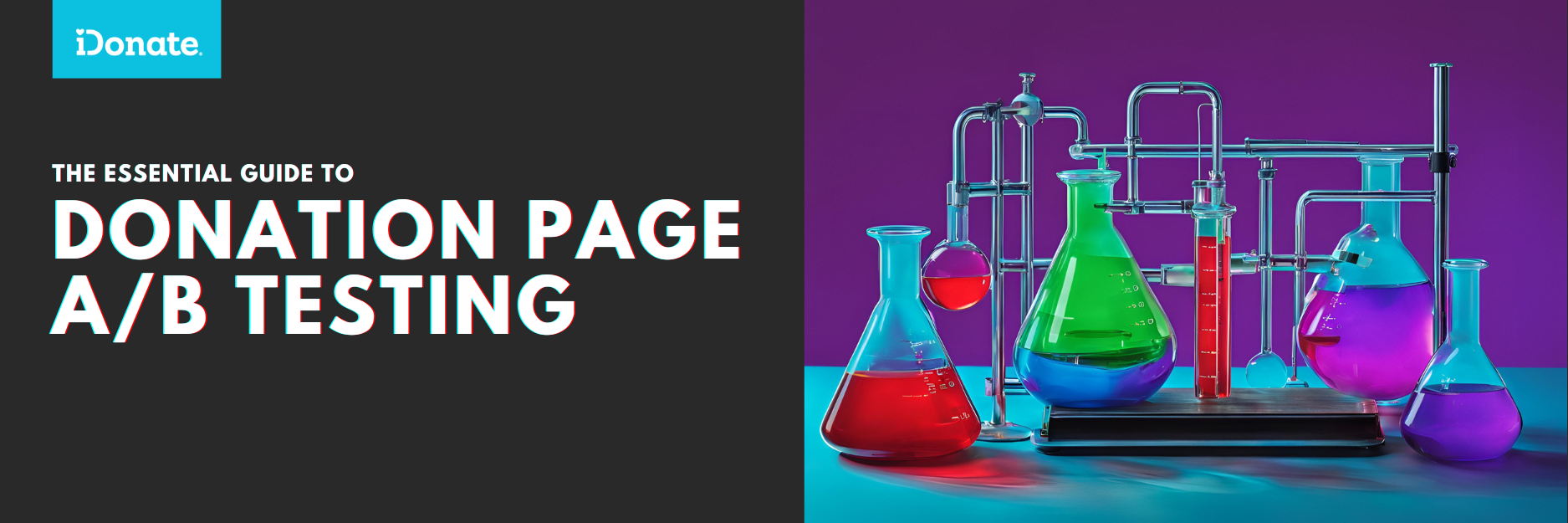Innovation Is the Shortest Route To Sustainable Growth
Innovation is an essential ingredient of any successful growth strategy. When we survey the for-profit world, we see innovation acting as a catalyst...

Use no-code tools to quickly build donation page variants, launch A/B tests, and get clear results that help you drive more donor conversions with a single platform.
New to online donation pages for your nonprofit? Start here.
Donation page A/B testing - no science degree needed.
Keep your donation page loading fast - and drive higher conversions.

In the for-profit world, businesses of all kinds, in virtually every industry, know that the only way to create relationships that lead to long-term customer value is by innovating. And the only way to innovate is by experimenting. Whether it’s rolling out new products, improving customer experiences, or trying new business models, it takes running experiments to fuel innovation. That’s how businesses learn, adapt, and grow.
In the course of experimenting with the ways in which they identify, connect to, and sustain relationships with their customers, these businesses can gain an understanding of what does and does not work. These organizations have learned to apply the idea that "everything is a test." And they prove time and again that experimentation works. They’ve established an experimentation mindset.
In an interview with Amazon founder and former CEO Jeff Bezos, he described the fundamental importance of experimenting in terms of the challenges and persistence required to do so:
“One area where I think we are especially distinctive is failure. I believe we are the best place in the world to fail (we have plenty of practice!), and failure and invention are inseparable twins. To invent you have to experiment.”
Experimentation isn’t something you can do just a few times a year. Like successful for-profit businesses, nonprofits need to run wide-ranging, frequent experiments to find the most beneficial ways to improve their products or services. And to do that, you need a culture where experimentation thrives at all levels and in all departments. This can – and often does – require a complete mindset shift, not just a few A/B tests here and there. In this sense, running experiments becomes as normal as running the numbers.
At Amazon, a history of trying out various new products and methods to see what resonates with customers and sellers has been key to its success. The creation of Amazon Prime and the Kindle are the best-known examples of experimentation producing significant, positive results. But along the way, there were failed experiments such as Amazon Destinations (hotel booking), and Endless.com (a high-end fashion site), among many others. None of these failures dealt a significant blow to the company, and the successes that came out of these experiments generated exponential profits.
Another leading example of how a commitment to persistent experimentation can literally transform a business is General Electric, where a culture of experimentation has created a foundation for growth and long-term success. In its early days, GE was merely a manufacturing company. Thanks to innovating with new products, marketing platforms, social media campaigns, and other techniques, GE has blossomed into a digital industrial company that serves the energy, healthcare, software, analytics, rail, and aviation industries.
At eBay, applying changes, testing, and experimenting has long been an important part of the company’s approach to its business. The online retailer’s administrators have carried out thousands of experiments, such as trying variations of the website experience. For example, two versions of a website can be set up within a matter of days, and the experiment will usually last at least a week.
Experimenting is deemed so essential to the company’s growth strategy that it has built its own application called eBay Experimentation Platform. It is used by testers to keep track of what happens and which pages are tested during which times.
Another strong example is Koch Industries, where I worked for one of the world’s greatest entrepreneurs. At any given time, there were hundreds of experiments across Koch. The ones that proved the thesis were funded, and the ones that didn’t were terminated. It all came down to experimenting.
Over the years, there have been countless examples of for-profit companies that started out with successful businesses but then failed to experiment and paid the ultimate cost of diminished relevance, lost customers, and declines in market share.
The very same mindset can be an equally powerful asset for today’s nonprofits to improve their overall fundraising results exponentially. At the moment, the vast majority of nonprofits are providing high-friction giving experiences, which are proven to suppress conversion rates. But NPOs can apply the same outlook – including persistent personalization, testing, experimenting, measuring, and re-testing. In this way, NPOs can focus on particular ways to refine, sharpen, and improve the donor experience.
The first step in creating an organizational culture that embraces experimentation is seeing failure as an essential ingredient of overall success. Without a failed experiment now and then, there can be no true breakthrough.
Experimentation doesn’t succeed or fail based on a single experiment. Nonprofits are advised to start with little things in developing a sense of what does and doesn’t work. Once you’ve discovered what works, you can implement your latest insights.
It’s one thing to have a gut feeling that something will work – it’s another thing altogether to see the data, which often proves gut feelings wrong. That’s why one of the surest and easiest ways to start off is to A/B test everything, from web pages to email subject lines. A/B testing allows you to measure with perspective – from which call-to-action lines to which emails generate the most clicks to which pages customers spend the most time on.
One of the most effective ways to generate ideas that can then be tested is to implement regular brainstorming sessions to design new tests. This ties in closely with the steps above. Choosing from a larger, versus smaller, list of potential tests will allow you to explore various dimensions of your nonprofit marketing and donor outreach.
If your hypothesis is true, you’ve found at least part of the answer. If it’s false, create a new hypothesis and go through the same testing process.
Startups in the for-profit world are constantly changing, always adapting to what their customers want, and trying to discover the best way of doing things. Businesses like Uber and Warby Parker, to name just two, have succeeded in large part because they foster a cultural mindset of experimentation in the service of innovation.
This means considering ideas that may not map to standard ways of doing things. It means making room for new, even radical ideas. These are the kinds of nuggets that often lead to the biggest successes.
And most importantly, nonprofits need to maintain the “test everything often” mentality. Testing to discover what works will help increase conversion rates over time and create a sustainable relationship with donors. From new design touches to new copy, to new social channels, you won’t know what may work until you try it. My friend Tim Kachuriak at NextAfter (a leading digital-first nonprofit agency) tells me all the time that the internet will ultimately provide you with the answer as long as you’re willing to let it. “Test everything” is his motto.
Armed with an approach to experimenting that is disciplined, organizationally aligned, and supported by an infrastructure, nonprofits can achieve a new level of growth and sustainability that will place them in a strong position for the future.
Talk to us here at iDonate, and we can show you how it's done.

Innovation is an essential ingredient of any successful growth strategy. When we survey the for-profit world, we see innovation acting as a catalyst...

Table of Contents Introduction What is A/B testing? A/B testing lingo Why should you run donation page A/B tests? What can you A/B test? How do you...

If there’s a key marker of where nonprofits stand today in terms of making progress in their fundraising, it’s the figure of 2%. That’s the...